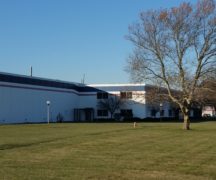By JAN LARSON McLAUGHLIN
BG Independent News
Bowling Green’s sewage will soon be part of a testing program to identify COVID-19 in the community.
The Ohio Department of Health and Ohio EPA have been sampling from several municipal sewage and wastewater treatment systems to determine the presence of coronavirus ribonucleic acid (RNA) fragments.
In other words – they are testing poop because coronavirus shows up there before it can be detected by testing a person.
“We were contacted by the EPA to see if they could come out and take samples of the wastewater and do COVID testing,” said Bowling Green Public Utilities Director Brian O’Connell. “We told them to come out and do it. If it helps to get more information about what’s going on, that’s a good thing.”
The testing of wastewater began in places like Cleveland, Columbus, Dayton, Cincinnati and Toledo.
“They have done it in bigger cities,” said Doug Clark, superintendent of Bowling Green’s wastewater treatment plant. “So now they are reaching out to other communities.”
The wastewater plant will send sample bottles twice a week to an Ohio EPA lab, where it will be tested at the EPA’s expense, Clark said. The staff at the Bowling Green plant will have to send information about the rainfall, PH levels, temperature, and when the samples were collected.
According to the Ohio EPA, virus RNA fragments are present in the feces of those who are both symptomatic and asymptomatic for COVID-19. So the samples gathered from raw wastewater may provide an early warning of disease occurrence in a community and possibly an estimation of the disease prevalence.
Emerging science at both the national and international level suggests that the virus in infected individuals can be detected in wastewater about three to seven days before there are increases in cases and hospitalizations, according to the EPA.
“I do think if this pans out the way they think, they might be able to use this in future pandemics sooner,” Clark said.
The research is being supported by $2 million in federal Coronavirus Aid, Relief, and Economic Security (CARES) Act funding.
Following is more information about the wastewater testing from the Ohio Department of Health:
Why Is This Being Done?
The increase of COVID-19 cases in communities is typically tracked by testing people with symptoms, an indicator that lags behind the actual spread of the disease. Because of this, there is a need to use early monitoring methods that estimate the disease’s impact on the broader community. Research in the U.S. and elsewhere has shown that non-infectious RNA (ribonucleic acid) from the virus that causes COVID-19 (called SARS-CoV-2) can be excreted in the feces of both symptomatic and asymptomatic infected people and can be detected in wastewater as many as three to seven days before those infections lead to increases in case counts or hospitalizations. As such, monitoring raw wastewater in sewage collection systems can provide an early warning of disease increase in a community. Community and public health leaders can use this early warning information to make decisions about protective actions to help limit further spread of the disease before cases begin to occur.
How Does It Work?
Wastewater entering treatment plants is sampled for fragments of the virus RNA. The wastewater comes from homes in the treatment plant service areas and travels through pipes to the plant. A mixed wastewater sample (24-hour composite) is collected in an area where all the sewage from a service area enters the plant. This sample is analyzed by a laboratory to determine the number of virus gene copies present, related to the wastewater flow that occurred on the sample day and the population that contributed to the flow. Based on current research, these virus fragments are not infectious at this sample collection point. It is important to note that the water discharged from the treatment plants is treated to remove viruses and bacteria and is monitored to meet all state and federal discharge limits.
Where Can I Find Results?
Click on a dot on the map to see the location of a collection site and obtain information on the viral gene copies detected in that location. (It is unknown when Bowling Green’s testing will begin, so the city is not yet on the map.) When available from the utility, the area displayed in light blue on the map shows the geographic boundaries of the service area collected by the sewer system that was sampled. The data will be updated at 2 p.m. on days when the Ohio Department of Health receives information from sampling sites. Currently that information is reported to the Ohio Department of Health two to three times per week, but as the network and sampling capacity expands the data will be updated daily.
What Do the Results Mean?
There are several factors to consider when interpreting viral data in wastewater. Because scientists are still learning about the timing and rate of shedding of the virus RNA in feces of infected people, it is only appropriate to monitor and observe the trends of viral gene copies detected in a community over time. The data presented in the graphs shows the total number of RNA copies detected in the area from which the wastewater was collected. A significant increase in viral gene copies over time is an indicator that cases may be increasing in the community. Because infected individuals can continue to shed the virus RNA in feces for 20 to 30 days after they are no longer infectious, decreases in the number of viral gene copies in wastewater might lag behind decreases in cases in a community. Trends in viral gene copies should be considered along with community case numbers and other COVID-19-related data to inform decisions about taking actions to help limit disease spread.
How Will the Ohio Wastewater Monitoring Network Improve Public Health?
The network will:
- Serve as an early warning of infection in communities or congregate settings.
- Provide information that can help local communities more quickly intervene with protective measures to slow disease spread.
- Help communities measure the effectiveness of such interventions (quarantine/face coverings/business limitations).
- Develop methodologies/predictive models to translate viral loads detected for comparison with other data, such as rates or percentage of infection in communities.
- Where possible, compare results to previously collected data on prevalence in specific communities to better understand factors affecting disease spread.
- Determine impacts on disproportionately affected communities or communities where risk of infection is greater.
Where Can I Find More Information on the Ohio Wastewater Monitoring Network?
Visit https://wrc.osu.edu/




